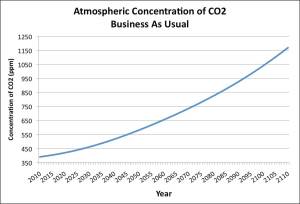Uncertainties
The challenge about predicting climate change is that the biosphere, the hydrosphere, and the atmosphere (and even to some extent the geosphere) are all affected and all interact. Those interactions feed on each other in ways we do not fully understand. For example as air temperatures and pressures change, wind patterns change, which change ocean currents, which affect the ocean biota, which affect the food chain. Also the precipitation patterns change, which change nutrients to the ocean, which affect ocean biota. And so on.
The changes we can expect are therefore uncertain, in both rate and magnitude. It is important to note that, just in the last decades, we have increased greenhouse gases to concentrations well over those seen in the past 800,000 years. The rates and magnitudes of change is unprecedented in geologic time. We don’t have examples from geologic time, at the rates we’re seeing today, to use to help evaluate changes we might expect. As discussed with the uncertainties surrounding sea level rise, we’re in uncharted waters.
Speed of Change
Because we don’t understand all the possible interactions and feedbacks, it is very difficult to confidently determine the speed of any changes. Glaciers typically melt slowly, but when ungrounded may melt very fast indeed.
However, a word of caution. Although the urgency is great, we need to move forward deliberately to mitigate the worst effects. In the next decade we will learn significantly more about what to expect and when to expect it. We need to start planning now, and putting a price on carbon would start the market working for us, which will take time to move up to prices that will modify behaviors and reduce fossil fuel demand. It is important to remember that we need to keep our economy strong. A strong economy is essential for building the innovation we need.
Paleocene-Eocene Thermal Maximum (PETM)
What we might be headed for in the centuries to come is like the Paleocene-Eocene Thermal Maximum, 56 million years ago. At that time there were no glaciers, it was 4-8°C (7-14°F) warmer, sea level was 75-90 meters (250-300 feet) higher and the Arctic Ocean temperature was about 70°F. Tropical! CO2 at that time was about 1000 ppm.
We are on track to reach a CO2 of 1000 ppm by 2100 based on data from MIT shown on the right. 
That’s if we do business as usual, which we hope all can see is not a good idea.
Of course a PETM scenario wouldn’t happen quickly. It will likely take centuries for all the ice in glaciers to melt. But make no mistake, if we take CO2 to 1000 ppm, they will melt.
Data on PETM are from Zachos et al., 2005, McInerney and Wing, 2011, and Wayne Clough, pers. com. 2014.
Click on figure to enlarge.
